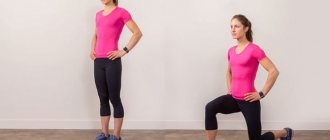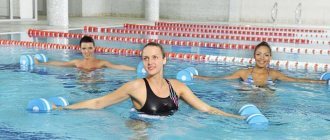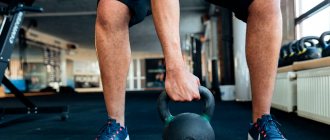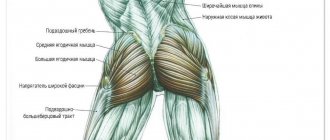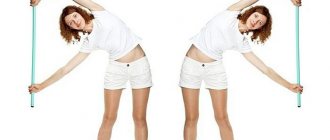The back is a sore spot for many people who are not always able to overcome this problem on their own. Pain and discomfort caused by overwork, sedentary work or age can be solved without a visit to massage parlors, but right on the chair. Before performing exercises, you should consult a doctor.
Source https://ncare.ru/
You need to start with relaxation. The purpose of the exercises is to warm up the muscles as much as possible and give long-awaited comfort. This can only be achieved in a relaxed and calm state.
The first exercise is breathing
You need to sit up straight, relax your shoulders and take 5 deep breaths in a row with your stomach, that is, inflating it. Inhalation and exhalation should be smooth, and the abdominal muscles should also be relaxed. After this, repeat 5 breaths, but straightening your chest as much as possible. There are only 10 breaths per approach, and it costs at least two to repeat them.
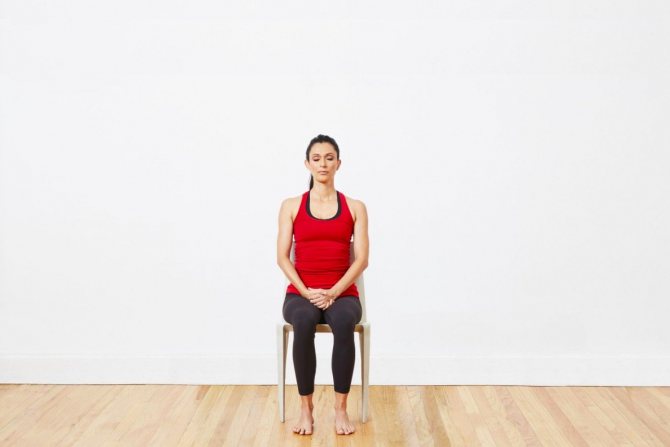
Source https://ultracarepro.in/
Second exercise – bending with a lock
You will have to sit back from the chair and cross your arms behind your back. Now take a deep breath and, as you exhale, slowly lower yourself down, preferably touching your chest to your knees. At the same time, your arms should be raised as high as possible, but without fanaticism - it shouldn’t hurt. Also smoothly rise and relax, lean back. You need to repeat the exercise 6-7 times, freezing at the bottom point for 10-15 seconds.
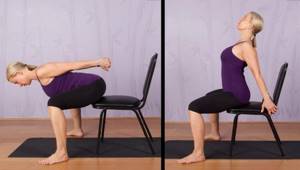
Source mifashionblog.com/chair-yoga-for-seniors
Which older people should exercise while sitting?
A set of exercises while sitting on a chair for older people can have a specific therapeutic focus, and individual exercises or a group of them can be an integral part of an exercise with a general strengthening effect on the aging body. The sitting position allows you to perform almost all types of breathing exercises, and also, if necessary, perform exercises with objects: a gymnastic stick, a hoop, a ball, expanders, a rubber band, dumbbells.
To treat a disease, a complex of exercise therapy while sitting on a chair should be compiled by a doctor. For preventive and general strengthening exercises, his approval of the selection of exercises will also be more than appropriate, and will help prevent the development of undesirable consequences.
For example, if you have problems with the lower back, bending forward is prohibited, and almost all photos and videos of complexes for the elderly sitting on a chair posted on the Internet contain this exercise without any reservations.
Exercise therapy classes while sitting on a chair are prescribed for older people:
- after an acute period of illness and transfer to semi-bed rest;
- after heart attacks and strokes, with cardiovascular and pulmonary diseases, the severity of which does not make it possible to exercise while standing, as well as receive cardio exercises (do exercises in motion, walk, work on an exercise bike, swim);
- in the treatment of gout, arthritis and arthrosis;
- with severe diabetes with complications in the heart and legs;
- temporarily or permanently using a wheelchair.
Doing simple physical exercises while sitting on a chair and at a calm pace is recommended for very old people who, due to profound age-related changes, cannot move and are forced to remain in bed, but can still sit.
On a note. For those elderly who feel cheerful and regularly engage in physical exercise, special sets of exercises have been compiled, performed while sitting on a fitball, including with objects in their hands. Such activities help to diversify physical activity and, due to performing exercises in an unusual position, have a beneficial effect on the activity of the brain and the central nervous system as a whole.
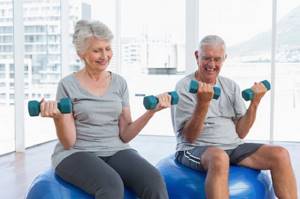
If you are pre-diabetic or have diabetes, be sure to exercise with dumbbells
Contraindications
For performing exercises while sitting on a chair, as for any other therapeutic or “regular” physical education, there are both specific and general contraindications.
Please note that physical therapy and exercises while sitting on a chair are prohibited if:
- pathologies that prohibit sitting in a sitting position, for example, after operations or fractures of the spine in the lumbar and sacral region, after fractures of the hip joint or with degenerative-dystrophic changes in it;
- acute pain syndrome in any part of the body or internal organ;
- acute form of an infectious or cold disease;
- high arterial, intraocular or intracranial pressure;
- elevated body temperature;
- poor health, which, according to experience, can lead to the development of a heart attack or hypertensive crisis.
Advice. If you have coxarthrosis (damage to the hip joint) or when recovering from a hip fracture, do not sit for as long as possible, especially do not do exercise therapy while sitting on a chair. Such exercises are only available at the final stage of rehabilitation. Exercise lying down, on all fours or standing.
Third exercise for back mobility
You need to sit on the edge of the chair and turn your body to the left, while your knees look strictly straight. You can help with your hands by grabbing the backrest and pulling yourself a little in the same direction. Now you need to return to the starting position and repeat the exercise to the right. It is important not to chase a 180° turn, only as far as your back allows at the moment: pain, crunching and unpleasant sensations are everything that should not happen in training.
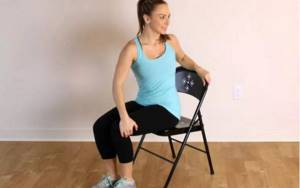
Source mombaby.tw/articlecategory/sport-fitness
Sets of exercises for muscle tone during sedentary work
Sets of exercises for muscle tone during sedentary work
1.Learning to sit correctly. The back should be straight. Neither the torso nor the head should be tilted forward. It is necessary to ensure that the stomach is slightly tense and the chin is parallel to the floor. The lower back should rest on the back of the chair, and the upper back should be supported by its own muscles. You can't fall over on one side. Relying on one hand (for example, the one that is free from the computer mouse) also leads to poor posture. The cross-legged position disrupts your posture. The correct position is one in which the legs are placed together.
2. Neck exercises
— In a sitting position, bend your neck, bringing your chin as close to your chest as possible, then slowly tilt your head back, trying to look behind your back. Extension of the neck must be done while inhaling, and flexion while inhaling.
- Turn your head to the left, fix it in this position, and then turn to the right.
— In a sitting position, “draw” numbers from 0 to 9 in the air with your nose. The range of neck movements should be full. Gently rotate your head 2-3 times, first clockwise, then in the opposite direction.
- Grasp the back of your head with your hands and fold them into a lock. Press them on the back of your head, and at the same time lower your head back, offering resistance.
3. Exercises for the hands.
- Grasp your left hand by the wrist with your right, rotate the hand 5 times clockwise, and the same number of times in the opposite direction. Repeat this exercise for your right hand.
— Quickly clench the fingers of both hands into fists 10 times. On the 10th count, clench your fists as hard as you can, hold them clenched for 3-5 seconds, then relax your fingers and shake them as if shaking off drops of water.
4. Warm up the thoracic and lumbar spine.
— Sitting on a chair. Hands rest on the back of the head, clasping each other (lock). You need to bend back so that the back of the chair rests on your back. As you inhale, bend back, and as you exhale, bend forward.
— Sitting on a chair with a straight back, legs slightly apart. You need to raise your hands up, clasp your left wrist with your right hand. Then lean to the right, pulling the left one. In this case, the tension of all muscles on the left side should be felt. After this, change the position of your hands and the side of the tilt.
— Exercise “scissors” with legs in a horizontal plane 5-10 times. When you inhale, your arms are brought together near your body, and when you exhale, they are moved to the side.
- Sit in the middle of the chair with your legs slightly apart. Grasp the right edge of the seat with your right hand. Place your left hand on the outer part of your right thigh. Stretch a little, turning your body to the right. Maintain this position for a few seconds, feeling the tension in your back muscles. Return to the starting position, relax and repeat the exercise, changing your hand and side of rotation.
— Sitting on a chair, hands on shoulders. It is necessary to make circular rotations with your arms, first forward, then backward.
5. Abdominal exercises
- Pull your stomach in, count to 5, return to the starting position. Repeat 10 times. Over time, it is advisable to increase the counting time to 10, and the number of exercise repetitions to 20.
— Tighten your abdominal muscles, counting to 5. Over time, you can increase the load.
6. Exercises for elasticity of muscles in the waist and hips.
- Sit on the floor, straighten your left leg, while twisting your right leg. Grab your left foot with your hands, lift it up and down. Try not to bend your leg at the knee. Repeat 10 times for each leg.
— Starting position: standing straight with crossed legs. It is necessary to stretch your arms forward, slowly bending your torso forward. Hold in this position for 5 seconds and return to the starting position.
- Starting position: kneel with your arms crossed above your head. You need to sit on your right thigh, straighten up and sit on your left. The exercise is repeated 10 times on each leg.
- You need to take a position in which your feet are parallel, and the distance between them is approximately 2 shoulder widths. The back is straight and should not be bent under any circumstances. The thighs are at an angle (ideally parallel to the floor), and the shins are perpendicular to the floor. To strengthen your hips, you need to stand in this stance for as long as possible; in addition, squats in the “rider’s stance” show good results. The main detail to remember is that the feet should be parallel to each other at a great distance, the legs bent at the knees.
7. Exercises for legs.
- Starting position: sitting on a chair, heels and toes together. It is necessary to lift your toes off the floor one by one, while keeping your heels in a stationary position. Repeat 10 times for each leg. Afterwards, lift your heels off the floor, and your toes should remain motionless. Repeat 10 times. — — Sitting on a chair, extend your right leg forward, tense your calves, pulling your toes towards you. Change your leg. Repeat the exercise 10 times.
- Give the gluteal muscles a workout. Tighten them, count to 3-5, then relax. Tighten your muscles a second time and count 5-7. Repeat the exercise 10 times. You can gradually increase the number of exercises and the time of tension.
It is known that sedentary work disrupts the blood flow to the brain, so a head and neck massage will be useful. Use your fingers to massage your neck along the vertebrae, moving up to the back of your head. To relieve general tension, you need to sharply tense all your muscles, and then completely relax, lowering your head and closing your eyes. Remain in this position for 15 seconds. Repeat the exercise if necessary.
Bless you!!!
Sincerely, Chernobokova N.V.
The fourth exercise for neck comfort and headache prevention
You should start with a light massage: rub the edge of your palm from the jaw to the shoulders. With each repetition, increase the pressure a little. When the muscles are “burning”, you can start the exercise. Press your cheek with your palm and try to turn your head in its direction. The resistance should not be strong so as not to accidentally injure the muscles. You need to stay in this position for 20 seconds, then change your hand. In the same way, bends forward and backward with emphasis on the forehead and back of the head are performed. Perform 3 sets of 2 repetitions on each side. After each repetition, rest for 10-15 seconds.

Source YouTube/LeNaR Wellness
Variant of the exercise with emphasis on the fist
Fifth exercise - warming up the lower body
Sit in the center of the chair, rise on your toes and lean forward. Next, we gradually transfer the weight to our legs, but do not get up from the chair. Freeze at the heaviest point for 20 seconds and return to the starting position. Repeat 7-8 times.
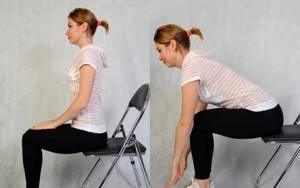
Source https://gimnastikasport.ru
Thanks to the complex, discomfort and pain will go away within a week, if, of course, you are not lazy. If the pain does not subside, you should postpone self-medication and be sure to visit a doctor, because it may not be just a matter of sedentary work or low activity.
Why do you need gymnastics in the workplace?
After spending the entire working day in a sitting position, a person tends to go home to relax, often choosing passive rest for this purpose. As a result of such a sedentary lifestyle, the functioning of all body systems is disrupted.
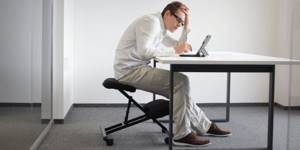
What does a sedentary lifestyle lead to:
- Constantly sitting in a sitting position causes improper redistribution of the load on the spine. This leads to compression of the intervertebral discs, poor posture, and improper muscle tone. As a result, you feel your back hurt, your posture loses its aesthetics, headaches and increased fatigue appear;
- in the pelvic area, blood circulation slows down, and as a result, all biological processes decrease. This leads to impaired sexual function and spastic constipation, when the intestines lose the ability to peristalsis and its natural emptying becomes impossible;
- blood circulation in the lower extremities is impaired. Over time, this leads to thromboembolism, numbness of the fingers, and disruption of the structure of the joints;
- lack of proper breathing loads leads to heart and lung diseases;
- reduced activity slows down blood circulation, deposits form on the walls of blood vessels, and problems with blood pressure appear;
- slower metabolism leads to excess weight gain;
- the general psycho-emotional state and brain activity worsen.
But it is worth recognizing that not everyone can afford to give up office or simply sedentary work. Therefore, there is a compromise solution that will help keep the body in good shape even with this lifestyle. And this is exercise at the workplace or, in other words, office gymnastics.
